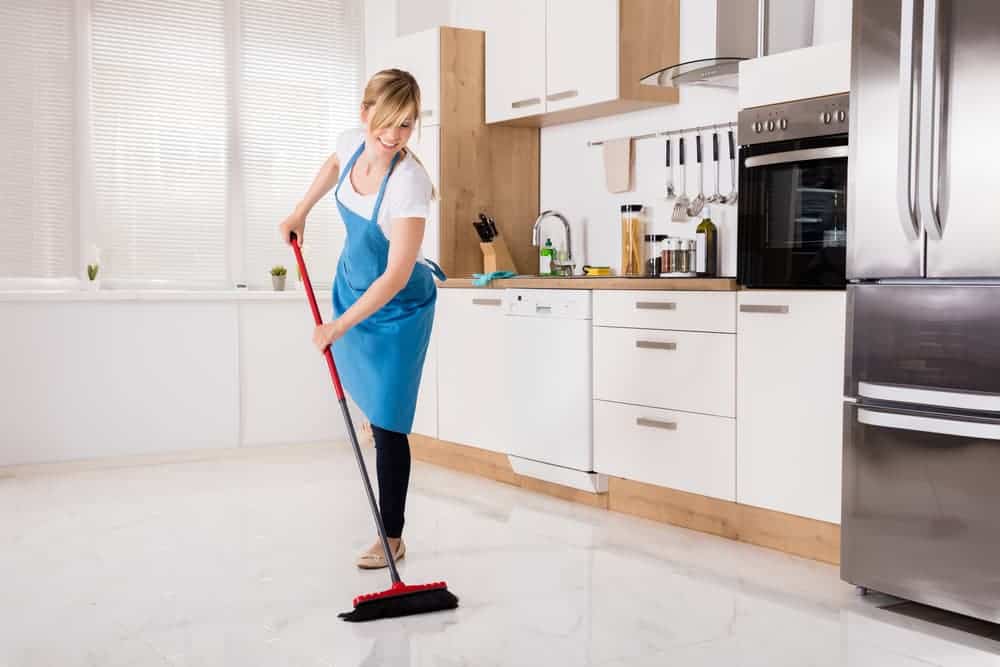Tile flooring for kitchens is a common choice among homeowners. It’s low maintenance plus durable, perfect for areas with high foot traffic. But over time, your once great-looking tile floors will look hazy and grimy. With the proper techniques and tools (plus elbow grease), it’s easy to put it back to its pristine condition!
How to Clean Your Ceramic Tile Flooring
Cleaning ceramic floor tiles is even easier when you have a list of steps to follow. So, here’s a guide to help you from start to finish. Make sure to take note of the cleaning tips as well.
1. Clean up visible dust and dirt
Make it a habit to sweep your tiled floor every day. Adding this to your kitchen cleaning checklist should prevent extreme dirt build-up or pest infestation. Regular sweeping can also free it from sand, which often causes glazed ceramic to lose its shine. Every week, you can vacuum your kitchen tiles to reach tight spots and corners.
2. Mop the floor
Fill your bucket with water and mild detergent or dish soap, then use it for mopping the floor. Make sure you pick the right mop for cleaning ceramic tiles. Ideally, use a rag, spin or chamois-type mop.
You can also use a towel if you want, but being on your hands and knees while scrubbing is not best for your back. Avoid using sponge mops, though. Aside from making your tile flooring cloudy, these can only make dirt seep into the grout lines, making grout cleaning difficult later on.
3. Rinse and dry the floor
Clean your mop to remove the soap, then start mopping the tiled floors with clean water. Once done, use a clean, lint-free cloth or microfiber towel to dry and buff it. The microfiber cloth can prevent streaks. Also, try not to leave the ceramic floors to air dry to avoid water spots.
At times, soap residue can be left out on certain spots, making them look dull. You can use a damp, soft cloth dipped in a non-abrasive all-purpose cleaner to remove the hazy film. You can also replace commercial cleaners with mild acids like fresh lemon juice. But make sure to avoid scrubbing the grout as the acid can react with it. Also, keep in mind that lemon juice suits ceramic or porcelain tiles only but not for stone tile floors.

4. Tackle stained spots
When cleaning your ceramic tile surface, keep an eye on discolouration or stains. Here are some cleaning methods you can try:
- Coffee or juice. Combine hot water and detergent in a small bowl. Then dip a clean cloth into the mixture and start scrubbing the stained ceramic tile surface. Rinse it before blotting the spot with diluted bleach or hydrogen peroxide. You can use this technique for cleaning blood stains, too.
- Grease. Clean the spot with water and club soda. You can also use a non-abrasive floor cleaner.
- Dye or ink. Soak a cleaning cloth in diluted bleach, then place it on top of the stained area. Leave it until the stain is gone. Rinse the spot thoroughly afterwards.
- Gum, wax or tar. Fill a resealable bag with some ice cubes, then place it on the stained surface. When the substance has solidified, carefully remove it with a stick. If some residue remains, scrub the spot with paint thinner.
5. Start grout cleaning
Your tile flooring is not fully clean if the grout is dirty. Porous grout lines can absorb dirt or stains quite easily. And so, grout cleaning needs extra tools and a bit more effort.
For a slight dirt build-up, spray grout cleaner or mild bleach solution along the lines. Let the solution sit for about 10 minutes before scrubbing the grout with a small brush or old toothbrush. Once clean, rinse the floor using a mop, then wipe it dry.
For tough grout stains, make a DIY grout cleaner by creating a paste out of baking soda and water. Rub the paste on the dirty grout, and leave it overnight. Scrub it the next day using a nylon brush. Rinse the floor thoroughly, wipe it dry then apply a silicone-based sealer to prevent future stains.
More Cleaning Tips for Ceramic Tile Flooring
- Use the soft-bristle brush attachment when vacuuming your ceramic tile floors.
- When mopping, change your water often. Muddy water can leave streaks on your tiles.
- Clean grout lines once every few months or when they start to look grimy.
- Use alkaline cleaners when you clean tile floors. Save the acidic cleaners for removing rust or limescale.
- Avoid oily cleaners for tiles as these can make the floor slippery and leave a stubborn residue.
- The lesser the tile floor cleaners used, the better. This tip prevents haziness and additional cleaning time for removing the cloudy film or residues left behind.
Are you having other flooring issues, like warped wood? I got the steps you need to make quick work of your timber floor repair.


